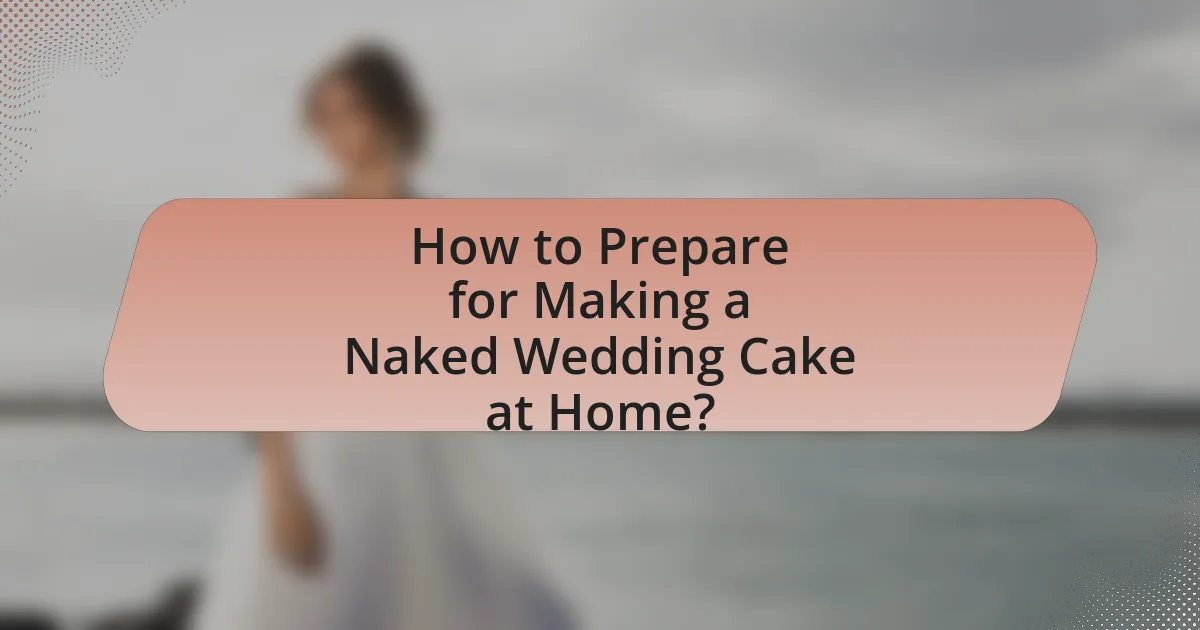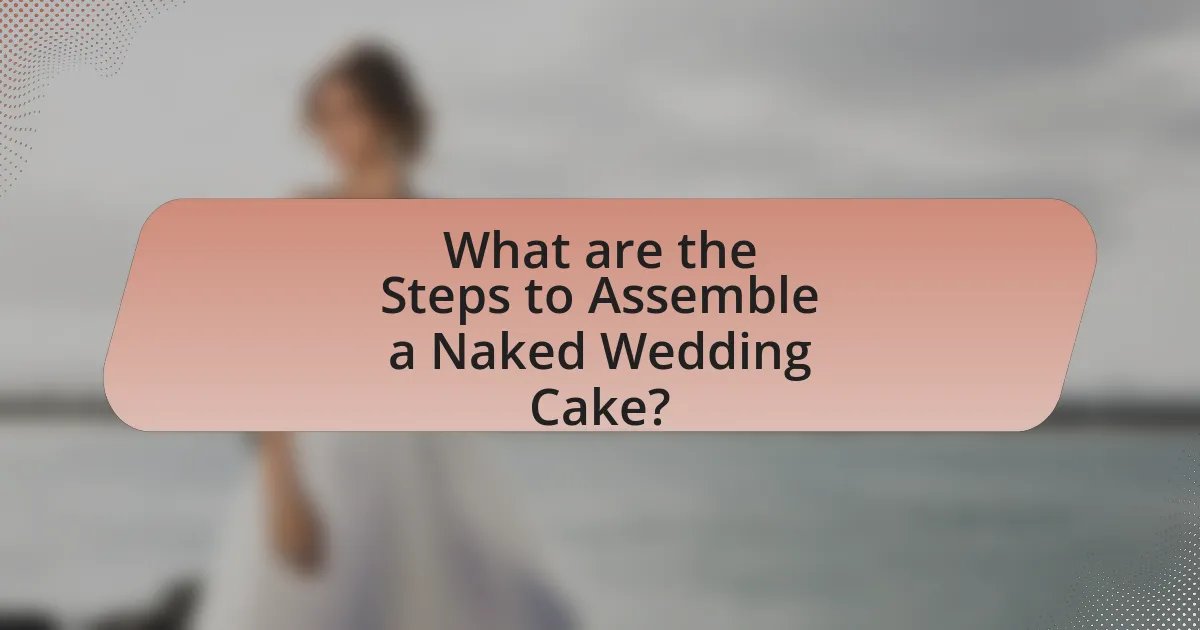A Naked Wedding Cake is a modern cake style characterized by its unfrosted sides, showcasing the layers and fillings, often adorned with fresh fruits and flowers. This article provides a comprehensive guide on how to make a Naked Wedding Cake at home, detailing essential components, flavor choices, and decoration techniques. It covers the differences between Naked Wedding Cakes and traditional cakes, key characteristics, and common mistakes to avoid during preparation and assembly. Additionally, it offers tips for personalizing the cake and ensuring its successful transport and storage before the event.

What is a Naked Wedding Cake?
A naked wedding cake is a type of cake that is intentionally left unfrosted on the sides, showcasing its layers and fillings. This style emphasizes a rustic and natural aesthetic, often adorned with fresh fruits, flowers, or minimal decorations. The absence of outer frosting allows the cake’s texture and ingredients to be visible, making it a popular choice for modern weddings.
How does a Naked Wedding Cake differ from traditional wedding cakes?
A Naked Wedding Cake differs from traditional wedding cakes primarily in its lack of frosting on the exterior. Traditional wedding cakes are typically fully covered in icing, which provides a smooth and polished appearance, while Naked Wedding Cakes showcase the exposed layers of cake and filling, creating a rustic and natural look. This style emphasizes the cake’s ingredients, often featuring fresh fruits, flowers, or other decorations that complement the layers, contrasting with the more ornate decorations commonly found on traditional cakes.
What are the key characteristics of a Naked Wedding Cake?
A Naked Wedding Cake is characterized by its minimalistic design, featuring exposed layers of cake without a full coating of frosting. This style emphasizes the natural beauty of the cake layers, often adorned with fresh fruits, flowers, or simple decorations. The absence of heavy icing allows for a more rustic and organic appearance, making it popular for outdoor or casual weddings. Additionally, Naked Wedding Cakes typically have a moist texture, as they are often filled with flavorful creams or jams between the layers, enhancing both taste and visual appeal.
Why has the Naked Wedding Cake become popular for weddings?
The Naked Wedding Cake has become popular for weddings due to its rustic aesthetic and simplicity, which appeals to modern couples seeking a more natural and less formal look. This style allows for the cake’s layers and fillings to be visible, showcasing fresh ingredients and often incorporating seasonal fruits and flowers, which enhances its visual appeal. Additionally, the trend aligns with the growing preference for personalized and unique wedding experiences, as couples opt for designs that reflect their individual tastes and the overall theme of their celebration.
What are the essential components of a Naked Wedding Cake?
The essential components of a Naked Wedding Cake include layers of cake, frosting or filling, and decorative elements. Naked wedding cakes typically consist of multiple tiers of cake, often made from flavors like vanilla, chocolate, or red velvet. The frosting or filling, which is usually a light buttercream or cream cheese, is applied between the layers but not on the outside, allowing the cake layers to be visible. Decorative elements often include fresh fruits, flowers, or herbs, which enhance the cake’s aesthetic while maintaining a rustic appearance. This structure is fundamental to the naked cake’s design, emphasizing simplicity and natural beauty.
What types of cake are best for a Naked Wedding Cake?
The best types of cake for a Naked Wedding Cake are sponge cakes, such as vanilla, chocolate, or lemon. These cakes provide a light and airy texture that complements the exposed layers and fillings typical of a naked cake. Additionally, they can be easily flavored and paired with various fillings like fruit preserves or whipped cream, enhancing the overall taste and presentation. Sponge cakes are also structurally sound enough to support the weight of the layers without the need for heavy frosting, which aligns with the aesthetic of a naked cake.
What fillings and frostings are commonly used in Naked Wedding Cakes?
Common fillings used in Naked Wedding Cakes include buttercream, cream cheese frosting, fruit preserves, and whipped cream. These fillings provide flavor and moisture while maintaining the cake’s rustic appearance. Frostings typically used are light buttercream, ganache, or cream cheese frosting, which complement the naked style by allowing the cake layers to be visible. The choice of fillings and frostings often reflects the couple’s preferences and seasonal ingredients, enhancing the overall taste and aesthetic of the cake.

How to Prepare for Making a Naked Wedding Cake at Home?
To prepare for making a naked wedding cake at home, gather essential ingredients and tools, including flour, sugar, eggs, butter, baking powder, and vanilla extract, along with baking pans, mixing bowls, and a spatula. The preparation process involves preheating the oven to the appropriate temperature, typically around 350°F (175°C), and greasing the baking pans to prevent sticking. Additionally, measuring ingredients accurately is crucial for achieving the desired cake texture and flavor. Following a reliable recipe ensures that the cake layers bake evenly, which is essential for a stable naked cake structure.
What ingredients do I need to make a Naked Wedding Cake?
To make a Naked Wedding Cake, you need flour, sugar, eggs, butter, baking powder, and milk. These ingredients form the basic structure of the cake. Flour provides the foundation, sugar adds sweetness, eggs contribute to the structure and moisture, butter enhances flavor and texture, baking powder acts as a leavening agent, and milk adds moisture to the batter.
How do I choose the right flavors for my Naked Wedding Cake?
To choose the right flavors for your Naked Wedding Cake, consider the preferences of the couple and the overall theme of the wedding. Popular flavor combinations include vanilla with fresh berries, lemon with lavender, and chocolate with salted caramel, as these pair well with the cake’s rustic aesthetic. Additionally, seasonal ingredients can enhance flavor selection; for example, using pumpkin spice in the fall or citrus flavors in the spring can create a harmonious experience. Ultimately, selecting flavors that resonate with personal tastes and complement the wedding’s atmosphere will ensure a memorable cake.
What tools and equipment are necessary for baking and assembling the cake?
To bake and assemble a cake, essential tools and equipment include mixing bowls, measuring cups and spoons, a whisk or electric mixer, a spatula, cake pans, an oven, a cooling rack, and a serrated knife. Mixing bowls are necessary for combining ingredients, while measuring cups and spoons ensure accurate ingredient quantities. A whisk or electric mixer facilitates thorough mixing, and a spatula helps in transferring batter. Cake pans are required for shaping the cake, and an oven is essential for baking. A cooling rack allows the cake to cool evenly, and a serrated knife is used for leveling and slicing the cake layers. These tools are standard in baking practices, ensuring successful cake preparation and assembly.
How do I plan the baking process for a Naked Wedding Cake?
To plan the baking process for a Naked Wedding Cake, start by determining the number of layers and flavors you want, as this will dictate the amount of ingredients needed. Next, create a detailed timeline that includes baking, cooling, and assembling the cake, ensuring you allocate enough time for each step; for instance, cakes typically need to cool for at least an hour before frosting. Gather all necessary ingredients and tools in advance, including cake pans, mixing bowls, and spatulas, to streamline the process. Finally, consider practicing the recipe beforehand to refine your technique and ensure the cake meets your expectations on the wedding day.
What is the best way to bake the cake layers evenly?
The best way to bake cake layers evenly is to use the correct oven temperature and ensure even heat distribution. Preheating the oven to the specified temperature, typically around 350°F (175°C), allows for consistent baking. Additionally, placing the cake pans in the center of the oven and avoiding overcrowding ensures that hot air circulates freely around each layer. Using light-colored, non-reflective pans can also help prevent over-browning. According to baking experts, these practices significantly reduce the risk of uneven baking, resulting in flat, level cake layers.
How can I ensure the cake layers are moist and flavorful?
To ensure cake layers are moist and flavorful, incorporate ingredients like buttermilk or sour cream, which add moisture and tanginess. These ingredients contain acids that tenderize the gluten in the flour, resulting in a softer texture. Additionally, using a simple syrup made from equal parts sugar and water can enhance moisture; brushing it onto the layers after baking helps retain moisture during storage. Research indicates that cakes made with buttermilk can be 20% moister than those made with regular milk, demonstrating the effectiveness of this approach.

What are the Steps to Assemble a Naked Wedding Cake?
To assemble a naked wedding cake, begin by baking and cooling the cake layers, ensuring they are level. Next, place the first layer on a cake board or serving platter, then spread a layer of frosting or filling on top. Add the second layer and repeat the frosting process. Continue stacking and frosting each layer until all layers are assembled. Finally, decorate the exterior with fresh fruits, flowers, or additional frosting, leaving the sides exposed to showcase the cake layers. This method is validated by common baking practices that emphasize the importance of even layers and proper frosting techniques for stability and aesthetics.
How do I stack and frost a Naked Wedding Cake?
To stack and frost a Naked Wedding Cake, begin by placing the first layer of cake on a sturdy cake board or plate. Then, add a layer of frosting on top of the first cake layer, spreading it evenly. Next, place the second cake layer on top of the frosted layer and repeat the frosting process. Continue stacking and frosting additional layers as desired. For a Naked Wedding Cake, the frosting should be minimal, allowing the cake layers to be visible. Ensure each layer is level and stable to prevent collapsing. This method is validated by professional bakers who emphasize the importance of stability and aesthetics in cake stacking.
What techniques can I use to achieve a rustic look?
To achieve a rustic look for a naked wedding cake, use techniques such as minimal frosting application, natural decorations, and textured finishes. Minimal frosting allows the cake layers to be visible, enhancing the rustic aesthetic. Natural decorations like fresh fruits, edible flowers, or herbs add organic elements that complement the rustic theme. Textured finishes can be achieved by using a spatula or a palette knife to create uneven surfaces on the frosting, giving the cake a handmade appearance. These techniques are commonly employed in rustic cake designs, making them effective for achieving the desired look.
How do I add decorations to enhance the Naked Wedding Cake?
To enhance a Naked Wedding Cake, incorporate fresh flowers, fruits, and greenery as decorations. Fresh flowers can be strategically placed between the cake layers or on top, adding color and elegance. Seasonal fruits, such as berries or citrus slices, can be arranged around the base or on the layers for a vibrant touch. Additionally, using sprigs of herbs or foliage can create a rustic feel, complementing the cake’s natural aesthetic. These elements not only beautify the cake but also align with the trend of using organic and natural decorations in wedding cakes, which has been increasingly popular in recent years.
What are some common mistakes to avoid when making a Naked Wedding Cake?
Common mistakes to avoid when making a Naked Wedding Cake include not leveling the cake layers, which can lead to an uneven structure, and using overly moist cake, causing it to collapse or become difficult to stack. Additionally, neglecting to properly support the layers with dowels can result in a cake that tilts or falls. Failing to apply a crumb coat before decorating can lead to unsightly crumbs in the final presentation. Lastly, not considering the stability of the filling can cause the layers to slide apart, compromising the cake’s integrity. These mistakes can significantly affect the appearance and stability of the Naked Wedding Cake.
How can I prevent the cake from collapsing during assembly?
To prevent the cake from collapsing during assembly, ensure that each layer is completely cooled and level before stacking. Cooling the layers allows them to firm up, reducing the risk of sagging, while leveling ensures a stable base for the layers above. Additionally, using a sturdy cake board under each layer provides extra support. According to baking experts, a well-structured cake with proper cooling and leveling techniques can significantly reduce the likelihood of collapse during assembly.
What should I do if my cake layers are uneven?
To fix uneven cake layers, level them using a serrated knife or a cake leveler. This method involves placing the cake on a flat surface, assessing the height differences, and carefully slicing off the domed tops to create a flat surface. This technique is widely used in baking, as it ensures that each layer is uniform, allowing for better stacking and presentation.

How can I personalize my Naked Wedding Cake?
To personalize your Naked Wedding Cake, incorporate unique flavors, fillings, and decorations that reflect your style and preferences. For example, you can choose a combination of cake flavors such as vanilla, chocolate, or lemon, and pair them with fillings like raspberry jam or cream cheese frosting. Additionally, you can adorn the cake with fresh flowers, fruits, or edible gold leaf to enhance its visual appeal. Personal touches like custom cake toppers or themed decorations can further distinguish your cake, making it a memorable centerpiece for your wedding.
What are some creative decoration ideas for a Naked Wedding Cake?
Creative decoration ideas for a Naked Wedding Cake include using fresh flowers, seasonal fruits, and edible greenery. Fresh flowers, such as roses or peonies, can be arranged artfully on the cake to enhance its natural beauty. Seasonal fruits like berries or citrus slices can add vibrant color and a fresh taste, while edible greenery, such as mint or eucalyptus, can provide a rustic touch. Additionally, incorporating elements like drizzled chocolate or caramel can add visual interest and flavor. These decoration methods are popular because they maintain the cake’s rustic aesthetic while adding elegance and personalization.
How can I incorporate seasonal fruits and flowers into my design?
To incorporate seasonal fruits and flowers into your design, select fruits and flowers that are in season during the time of your event, as they will be fresher and more vibrant. For example, strawberries and peonies in spring or figs and sunflowers in late summer can enhance the visual appeal of a naked wedding cake. Using these seasonal elements not only adds color and texture but also aligns with the farm-to-table trend, which emphasizes the use of local and seasonal ingredients. This approach ensures that your design is not only aesthetically pleasing but also supports sustainable practices.
What are some unique flavor combinations to consider?
Some unique flavor combinations to consider for a naked wedding cake include lemon and lavender, chocolate and raspberry, and vanilla and chai. Lemon and lavender create a refreshing and aromatic profile, while chocolate and raspberry offer a rich and fruity contrast. Vanilla and chai blend the classic sweetness of vanilla with the warm spices of chai, resulting in a comforting and unique taste experience. These combinations enhance the overall flavor profile of the cake, making it memorable for guests.
What tips can help ensure my Naked Wedding Cake is a success?
To ensure your Naked Wedding Cake is a success, focus on using high-quality ingredients and maintaining proper moisture levels. High-quality flour, fresh eggs, and real butter contribute to a better texture and flavor, while ensuring the cake layers are adequately moist prevents them from crumbling. Additionally, consider using a simple syrup to enhance moisture retention. Proper stacking and support are crucial; use dowels or cake boards to stabilize the layers and prevent collapsing. Lastly, decorate with fresh fruits or flowers, as they not only enhance the visual appeal but also complement the cake’s flavor. These practices are supported by baking experts who emphasize the importance of ingredient quality and structural integrity in cake design.
How can I effectively transport my Naked Wedding Cake to the venue?
To effectively transport your Naked Wedding Cake to the venue, use a sturdy cake box or a cake carrier that provides adequate support and protection. Ensure the cake is chilled before transport to minimize movement and potential damage. Secure the cake with non-slip mats or cake boards to prevent sliding during transit. Additionally, drive carefully and avoid sudden stops or sharp turns, as this can cause the cake to shift. These methods are validated by professional bakers who emphasize the importance of stability and temperature control in cake transportation.
What are the best practices for storing a Naked Wedding Cake before the event?
The best practices for storing a Naked Wedding Cake before the event include keeping it in a cool, dry place, ideally in the refrigerator, to maintain freshness and prevent spoilage. Naked cakes, which lack frosting that seals in moisture, are particularly susceptible to drying out, so wrapping the cake layers in plastic wrap or placing them in an airtight container can help retain moisture. Additionally, it is advisable to avoid stacking the layers until just before serving to prevent them from becoming unstable. These practices ensure that the cake remains fresh and visually appealing for the event.
